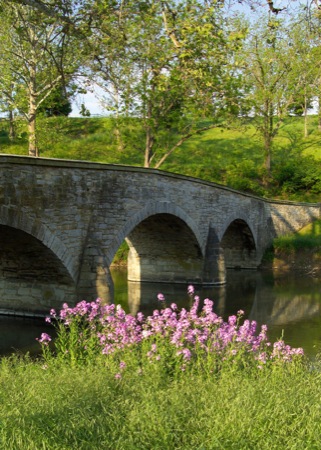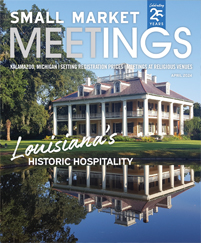
Courtesy Hagerstown-Washington Co. CVB
Hagerstown has always been a hub. Situated in western Maryland where Virginia, Pennsylvania and West Virginia converge in the Great Appalachian Valley, it stands at historic crossroads.
Native Americans once trod the valley’s Great Indian Warpath. Later, German and Scots-Irish immigrants headed south from Pennsylvania on what they called the Great Wagon Road.
Among them was German-born fur trader and town namesake Jonathan Hager. In 1739, he staked his claim on 200 acres of land and built a stone house, now a museum in the city. The limestone he used was plentiful and popular, giving the city many handsome white stone buildings along its older streets.
In the 1800s, one of the country’s first federal highways, the National Road, took settlers west through Hagerstown; railroad tracks soon followed. Union and Confederate troops skirmished back and forth across the Mason-Dixon line and fought the bloodiest one-day battle in American history at nearby Antietam.
Still a crossroads
Times have changed, but Hagerstown remains a crossroads. Busy Interstates 81 and 70 intersect west of town, and that is where most of Hagerstown’s growth is today. About three miles from the split, off I-70, Hagerstown Premium Outlets and its 100 stores are a major attraction, drawing shoppers from as far as metro D.C.
Where the two interstates intersect is also populated with efficient, attractive limited-service brand hotels that offer all the amenities a meeting planner could want, except for size and a sense of place.
The one exception is an older property, the recently renovated 158-room Ramada Plaza, with its 200-person ballroom, four meeting rooms and two boardrooms. In late July, it played host to a group of Civil War historians who used it as a base for a four-day program that explored area battlefields.
Nearby, Hagerstown entrepreneur Don Bowman has begun weaving together a “hospitality campus” that includes an upscale Homewood Suites by Hilton and a midscale 84-room Holiday Inn Express. If all goes well, he said he plans to add another Hilton hotel with more meeting space, “on the order of 5,000 square feet” and several more restaurants to complement the Outback and Buffalo Wild Wings already open.
Bowman is also involved in reinvigorating downtown Hagerstown.
The Homewood Suites he built three years ago is a residential-style property with 102 guest suites and 2,400 square feet of meeting space.
Its homey atmosphere goes beyond a complimentary hot breakfast — here, guests can have a light dinner in a first-floor gathering area called the Lodge, shoot basketball, play shuffleboard and putt-putt, and have down-home country barbecue on the patio each Tuesday night.
There’s another plus for meeting planners, according to Francine Donachie, director of sales and marketing for Bowman Hospitality.
“Groups of 25 or more get a complimentary hospitality suite.”
And groups staying at the Homewood or Bowman’s Holiday Inn Express, which is undergoing a $1 million refurbishment, can use the amenities of either hotel, including breakfasts and dinners.
The interstate area’s newest hotel, opened in August 2010, is the 92-room Courtyard Hagerstown near Hagerstown’s Valley Mall. Its main meeting room, for 64, opens onto a courtyard.
“During the first half of 2011, our hotel tied for third among Marriott’s 817 Courtyards in North America on the company’s random surveys of customer satisfaction,” said Sharon Bear, who manages this hotel and an adjacent SpringHill Suites that opened three years ago.
East of town
Several older properties along the Dual Highway on the east side of town have larger meeting facilities.
The Clarion Hotel and Conference Center and Hager Hall Conference and Event Center have separate owners, but you’d never know it, because the two are physically connected.
Combined, they have more than 40,000 square feet of meeting space.
The 20-year-old Clarion underwent a $5 million renovation in 2009 and last year won a Gold Hospitality Award from Choice Hotels International.
Its 12,000-square-foot tropical atrium, with a pool, a bar and a small cafe where breakfast is served, can also be used for banquets and receptions for up to 200 people.
About half of the hotel’s 144 guest rooms encircle the atrium on two levels; the rest, which have natural light, are brighter.
The hotel’s meeting space is dominated by three 2,400-square-foot learning centers, originally built as training sites for NASA. Each is soundproof and has three small breakout rooms, built-in audiovisual, a small kitchen and its own restrooms.
“You can even bring in your own food,” said hotel owner Sue Uka, “or we can provide it.”
Walk through a doorway from the Clarion Conference Center and you’re in Hager Hall, a meeting facility. Its 16,000-square-foot ballroom can be carved into eight smaller rooms around a central area with a stage. There is also a 2,000-square-foot junior ballroom. Parking is plentiful, and wide doors have let in everything from cars to a giraffe, said Bonnie Waltman, sales director.
Hager Hall’s restaurant, Barefoot Bernie’s, makes iconic Maryland crab cakes, and there’s entertainment most nights in Cancun Cantina West that includes such diverse fare as a disc jockey, line-dancing lessons, a rock band and country music.
Outside, a deck bar is often the setting for meeting ice-breakers. “This is the tropics in western Maryland,” said Waltman.
The granddaddy of hotels along the Dual Highway is the Hagerstown Hotel and Convention Center. Sold several years ago by the Hagerstown businessman who ran it successfully for 40 years, the hotel fell on hard times.
Earlier this year, an investment firm bought it, and it is making a comeback, said sales director Kathy Burns.
“We are truly a hotel again,” she said.
Carl Pedersen agrees. In June, he chaired the International Association of Torch Clubs convention there. “They did a magnificent job,” he said.
The 108-room hotel has nearly 11,000 square feet of meeting space, including a divisible ballroom that can seat up to 500.
There’s also a smaller ballroom, three meeting rooms and a boardroom decorated with a mural that depicts the area’s history. A full-service restaurant includes a semiprivate area for groups of up to 50.
Mary Ellen Cohn, executive director of the Maryland Music Educators Association, used the Clarion and the Hagerstown Hotel this spring for Maryland’s all-state chorus and orchestra rehearsals.
“We needed hotels where 270 kids could stay safely. And we needed large rehearsal spaces with high ceilings and unobstructed views. These hotels fit that bill, and we plan to return next year,” she said.
A third property along the Dual Highway is the 86-room Best Western Grand Venice Hotel, Wedding and Conference Center, with 10 meeting rooms. A large new outdoor pool area is available for events.
Nothing close comes close
Although Hagerstown is a small town, with a population hovering around 40,000, it is the largest in the region, serving a metro population of over a quarter-million, including Martinsburg, W.Va.
Because of its status as the hub of a wider area, Hagerstown has more meeting space than is typical for a city its size.
“We have the most meeting space outside of the major cities, and we’re less expensive,” said Betsy DeVore, director of sales for the Hagerstown Washington County Convention and Visitors Bureau. “Nothing close comes close.”
The city also has other benefits, such as free wired and wireless Internet access at all of its hotels.
Associations and the SMERF (social, military, educational, religious and fraternal) market are important in Hagerstown, DeVore said, but the city also attracts gatherings like the National Ayrshire Cattle Convention held in June at the Clarion.
“More and more, convention planners want activities for families,” she said. Hagerstown offers the Hagerstown Suns, its minor league baseball team; a symphony orchestra; a theater; an ice and sports complex; cycling along the C&O Canal; and historic sites, like Antietam.
No one should leave Hagerstown without visiting the Civil War battlefield, where 23,000 Union and Confederate soldiers were killed or wounded during one furious day of combat, Sept. 17, 1862. It was the bloodiest day in American history.
Art and swans
Hagerstown’s off-site venues range from upscale to down-on-the-farm, and several have recently added new meeting venues.
This year a courtyard at the Washington County Museum of Fine Arts became a 3,000-square-foot atrium with the addition of a glass roof. The space is popular for receptions at the museum, which opened in 1931.
The brainchild of a husband-and-wife philanthropist team, the museum originally was a baronial “hall for tall works,” European Renaissance and Baroque paintings. It has since focused on 19th- and 20th-century American art. The museum, which overlooks a 54-acre swan lake in City Park, charges no admission.
Moving from sublime to casual, you can head southwest to Williamsport, a small town that grew up along the C&O Canal. The town’s Barn at Springfield Farm is a good site for laid-back catered events or meetings for up to 250 people, May through October. It has no heat or air conditioning.
Parts of the enormous frame barn date back to 1776. Today, it has a stage, side doors that slide open to a lawn, new bathrooms and a kitchen. It’s used for events from fashion shows and concerts to a World War II reunion every October. There’s also a small museum that tells the stories of the little canal town.
Northeast of town, Cortland Mansion is not a rambling old estate; it’s a spacious 10-year-old banquet hall for 300 people that could also be used for a trade show. Built on one level, it also has a patio for receptions of 60 to 75.
Northwest of town, Knob Hall has been in the Seibert family for 200 years. Now Dick Seibert and his wife, Mary Beth, grow grapes and make wine at the Knob Hall Winery. Last year, they won three gold medals in Maryland wine competition.
This month, they will begin a yearlong renovation of their 1860 barn. They promise a tasting room and event space for 120 sometime in 2012.
“In the meantime, we can do events for 30 to 50 in another building,” Seibert said, “and we’ll be open all winter.”
Downtown sparkles
Downtown Hagerstown, like many small cities, has struggled in recent years.
“But we’re feeling better about it,” said Bowman, who, in addition to building new hotels, is a leader in efforts to preserve the town where he grew up.
“We have many beautiful churches. We’re building a new library, and we’re looking for continued improvement,” he said.
The city’s small arts and entertainment area has a theater, a couple of banquet rooms and several restaurants with space for groups.
Bulls and Bears, Bowman’s restaurant, has private areas for groups of 10 to 80. The popular Schmankerl Stube Bavarian Restaurant has three private dining rooms that can each seat 35 and an open-air “biergarten.”
And after dark, as the lights go on, Hagerstown’s streets begin to sparkle.
“The town came up with that,” Bowman said. “When we redid the sidewalks and curbing in the arts and entertainment area, we added glitter when we paved the streets. The fact that you remember it probably means it was worthwhile.”











